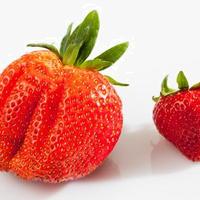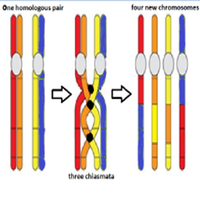 Topic 10: Genetics and evolution
Topic 10: Genetics and evolution
This is an introduction to the HL genetics and evolution topic. It lists understandings and skills expected for Topic 10 including crossing over, chiasmata, recombinant phenotypes, linked genes, polygenic inheritance, polyploidy and gene pools. Helpful for revision.
Detailed revision notes, activities and questions can be found on each of the sub-topic pages.
- 10.1 Meiosis
- 10.2 Inheritance
- 10.3 Gene pools and speciation
10.1 Meiosis
Crossing over
- DNA replication makes a second chromatid in each chromosome in interphase before meiosis.
- Crossing over exchanges pieces of DNA between non-sister homologous chromatids and forms new combinations of alleles on the chromosomes formed in meiosis.
- Chiasmata are the crossing over points
Chromosomes movements
- Details of chromosome movements in meiosis. ie:
- Homologous chromosomes separate in meiosis I.
- Sister chromatids separate in meiosis II.
- Random orientation of homologous chromosomes in meiosis I leads to independent assortment of alleles.
Student skills and applications
- Drawing diagrams to show chiasmata formed by crossing over.
- show sister chromatids still closely aligned, except at the point where crossing over occurred and a chiasma was formed.
10.2 Inheritance
Linked genes
- Genes are linked when they occur on the same chromosome.
- Unlinked genes show independent segregation in meiosis.
Polygenic inheritance
- Variation between living can be discrete or continuous.
- Phenotypes controlled by many genes (polygenic) show continuous variation. They may also be influenced by environmental factors.
- Chi-squared tests are used to calculate if differences between observed and expected frequencies are statistically significant.
Student skills and applications
- A awareness of Morgan’s discovery of non-Mendelian ratios in Drosophila.
- The ability to complete Punnett squares for dihybrid traits and analyse them.
- Ability to calculate predicted genotype ratios and phenotype ratios of offspring of dihybrid crosses involving unlinked autosomal genes.
- The skill to identify recombinant phenotypes and gametes in crosses involving two linked genes and to understand when they are shown as vertical pair in crosses of linked genes.
- The skill to use of a chi-squared test on data from dihybrid crosses.
10.3 Gene pools and speciation
Gene pools
- A gene pool consists of all the genes and their different alleles, present in an interbreeding population.
- Evolution requires that allele frequencies change with time in populations.
- Punctuated equilibrium implies long periods without appreciable change and short periods of rapid evolution.
Speciation
- Reproductive isolation of populations can be temporal, behavioural or geographic.
- Speciation due to divergence of isolated populations can be gradual.
- Speciation can occur abruptly.
Student skills and applications
- Application: Identifying examples of directional, stabilising and disruptive selection.
- Application: Speciation in the genus Allium by polyploidy.
- Skill: Comparison of allele frequencies of geographically isolated populations.

Gene pools and speciation 10.3 HL
The concept of gene pools is important to the understanding of natural selection. There are three types of selection pressure covered in this topic, stabilising, directional and disruptive. Reproductive isolation is also covered.

Inheritance 10.2 HL
Inheritance has been covered in the SL genetics topic already so this HL topic covers dihybrid crosses and the discovery of linkage by Morgan with Drosophila flies.

Meiosis 10.1 HL
This topic is all about the higher level details of meiosis. That includes the formation of a chiasmata in crossing over and the movement of chromosomes during the two division of meiosis. Remember some details of meiosis have also been covered in SL.


 Twitter
Twitter  Facebook
Facebook  LinkedIn
LinkedIn